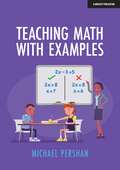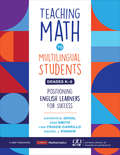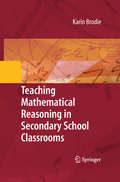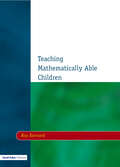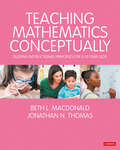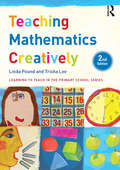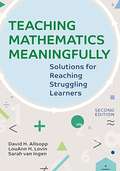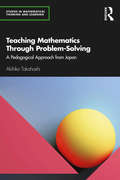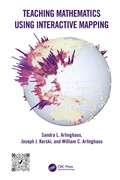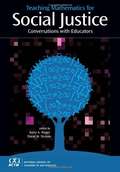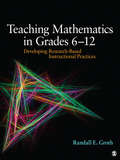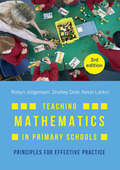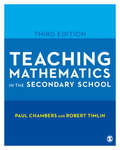- Table View
- List View
Teaching Math With Examples
by Michael PershanSome teachers think that there’s little to say about teaching with examples – after all, everyone uses them. But here are just some of the questions you might have about teaching with worked examples:How do we introduce an example?What do we ask students to do when studying a solution?Should a solution be presented all at once or revealed step-by-step?After we study an example, what comes next?Does it matter if the solution is presented as if from a fictional student, a real student in class, or from the teacher?How do we help students move from understanding someone else’s ideas towards using it on their own to solve problems?How do we write a solution in a clear way, that students can learn from?When is a good time to offer a worked example? When is it better to let students try a problem?Are worked examples more useful for some mathematical content than others?This book will answer all of these questions. In some cases, research offers answers. Other questions represent gaps in the research literature and the book offers solutions arrived at through experience and trial-and-error and the author’s own process of classroom problem solving.Welcome to the world of teaching with examples!
Teaching Math at a Distance, Grades K-12: A Practical Guide to Rich Remote Instruction (Corwin Mathematics Series)
by Theresa E. WillsMake Rich Math Instruction Come to Life Online In an age when distance learning has become part of the "new normal," educators know that rich remote math teaching involves more than direct instruction, online videos, and endless practice problems on virtual worksheets. Using both personal experience and those of teachers in real K-12 online classrooms, distance learning mathematics veteran Theresa Wills translates all we know about research-based, equitable, rigorous face-to-face mathematics instruction into an online venue. This powerful guide equips math teachers to: Build students’ agency, identity, and strong math communities Promote mathematical thinking, collaboration, and discourse Incorporate rich mathematics tasks and assign meaningful homework and practice Facilitate engaging online math instruction using virtual manipulatives and other concrete learning tools Recognize and address equity and inclusion challenges associated with distance learning Assess mathematics learning from a distance With examples across the grades, links to tutorials and templates, and space to reflect and plan, Teaching Math at a Distance offers the support, clarity, and inspiration needed to guide teachers through teaching math remotely without sacrificing deep learning and academic growth.
Teaching Math at a Distance, Grades K-12: A Practical Guide to Rich Remote Instruction (Corwin Mathematics Series)
by Theresa E. WillsMake Rich Math Instruction Come to Life Online In an age when distance learning has become part of the "new normal," educators know that rich remote math teaching involves more than direct instruction, online videos, and endless practice problems on virtual worksheets. Using both personal experience and those of teachers in real K-12 online classrooms, distance learning mathematics veteran Theresa Wills translates all we know about research-based, equitable, rigorous face-to-face mathematics instruction into an online venue. This powerful guide equips math teachers to: Build students’ agency, identity, and strong math communities Promote mathematical thinking, collaboration, and discourse Incorporate rich mathematics tasks and assign meaningful homework and practice Facilitate engaging online math instruction using virtual manipulatives and other concrete learning tools Recognize and address equity and inclusion challenges associated with distance learning Assess mathematics learning from a distance With examples across the grades, links to tutorials and templates, and space to reflect and plan, Teaching Math at a Distance offers the support, clarity, and inspiration needed to guide teachers through teaching math remotely without sacrificing deep learning and academic growth.
Teaching Math to Multilingual Students, Grades K-8: Positioning English Learners for Success (Corwin Mathematics Series)
by Kathryn Chval Erin Marie Smith Lina Trigos-Carrillo Rachel JaDean PinnowUsing strengths-based approaches to support development in mathematics It’s time to re-imagine what’s possible and celebrate the brilliance multilingual learners bring to today’s classrooms. Innovative teaching strategies can position these learners as leaders in mathematics. Yet, as the number of multilingual learners in North American schools grows, many teachers have not had opportunities to gain the competencies required to teach these learners effectively, especially in disciplines such as mathematics. Multilingual learners—historically called English Language Learners—are expected to interpret the meaning of problems, analyze, make conjectures, evaluate their progress, and discuss and understand their own approaches and the approaches of their peers in mathematics classrooms. Thus, language plays a vital role in mathematics learning, and demonstrating these competencies in a second (or third) language is a challenging endeavor. Based on best practices and the authors’ years of research, this guide offers practical approaches that equip grades K-8 teachers to draw on the strengths of multilingual learners, partner with their families, and position these learners for success. Readers will find: • A focus on multilingual students as leaders • A strength-based approach that draws on students’ life experiences and cultural backgrounds • An emphasis on maintaining high expectations for learners’ capacity for mastering rigorous content • Strategies for representing concepts in different formats • Stop and Think questions throughout and reflection questions at the end of each chapter • Try It! Implementation activities, student work examples, and classroom transcripts With case studies and activities that provide a solid foundation for teachers’ growth and exploration, this groundbreaking book will help teachers and teacher educators engage in meaningful, humanized mathematics instruction.
Teaching Math to Multilingual Students, Grades K-8: Positioning English Learners for Success (Corwin Mathematics Series)
by Kathryn Chval Erin Marie Smith Lina Trigos-Carrillo Rachel JaDean PinnowUsing strengths-based approaches to support development in mathematics It’s time to re-imagine what’s possible and celebrate the brilliance multilingual learners bring to today’s classrooms. Innovative teaching strategies can position these learners as leaders in mathematics. Yet, as the number of multilingual learners in North American schools grows, many teachers have not had opportunities to gain the competencies required to teach these learners effectively, especially in disciplines such as mathematics. Multilingual learners—historically called English Language Learners—are expected to interpret the meaning of problems, analyze, make conjectures, evaluate their progress, and discuss and understand their own approaches and the approaches of their peers in mathematics classrooms. Thus, language plays a vital role in mathematics learning, and demonstrating these competencies in a second (or third) language is a challenging endeavor. Based on best practices and the authors’ years of research, this guide offers practical approaches that equip grades K-8 teachers to draw on the strengths of multilingual learners, partner with their families, and position these learners for success. Readers will find: • A focus on multilingual students as leaders • A strength-based approach that draws on students’ life experiences and cultural backgrounds • An emphasis on maintaining high expectations for learners’ capacity for mastering rigorous content • Strategies for representing concepts in different formats • Stop and Think questions throughout and reflection questions at the end of each chapter • Try It! Implementation activities, student work examples, and classroom transcripts With case studies and activities that provide a solid foundation for teachers’ growth and exploration, this groundbreaking book will help teachers and teacher educators engage in meaningful, humanized mathematics instruction.
Teaching Mathematical Reasoning in Secondary School Classrooms
by Nico Molefe Stephen Modau Lorraine Lauf Romulus O'Brien Karin Brodie Kurt CoetzeeFor too many students, mathematics consists of facts in a vacuum, to be memorized because the instructor says so, and to be forgotten when the course of study is completed. In this all-too-common scenario, young learners often miss the chance to develop skills--specifically, reasoning skills--that can serve them for a lifetime. The elegant pages of Teaching Mathematical Reasoning in Secondary School Classrooms propose a more positive solution by presenting a reasoning- and discussion-based approach to teaching mathematics, emphasizing the connections between ideas, or why math works. The teachers whose work forms the basis of the book create a powerful record of methods, interactions, and decisions (including dealing with challenges and impasses) involving this elusive topic. And because this approach shifts the locus of authority from the instructor to mathematics itself, students gain a system of knowledge that they can apply not only to discrete tasks relating to numbers, but also to the larger world of people and the humanities. A sampling of the topics covered: Whole-class discussion methods for teaching mathematics reasoning. Learning mathematical reasoning through tasks. Teaching mathematics using the five strands. Classroom strategies for promoting mathematical reasoning. Maximizing student contributions in the classroom. Overcoming student resistance to mathematical conversations. Teaching Mathematical Reasoning in Secondary School Classrooms makes a wealth of cutting-edge strategies available to mathematics teachers and teacher educators. This book is an invaluable resource for researchers in mathematics and curriculum reform and of great interest to teacher educators and teachers.
Teaching Mathematically Able Children
by Roy KennardThis work aims to help primary and secondary teachers to recognize and teach mathematically able pupils. Roy Kennard reviews the characteristics of the very able pupils and shows how these characteristics are reflected in the National Curriculum for Mathematics. He goes on to show how: mathematically able children can be challenged through problem solving and interactive discussion; and the use of in-depth case studies and other examples of pupils' work makes it possible for teachers to see the consequences of the approaches discussed. This text also considers whole school organizational and leadership approaches and should be useful to school management teams or "gifted and talented coordinators." This revised and updated second edition should be of interest to teachers, advisers, lecturers and students with an interest in securing effective provision for mathematically able pupils.
Teaching Mathematics
by Paul ChambersReflective practice is at the heart of effective teaching, and this book helps you develop into a reflective teacher of mathematics. Everything you need is here: guidance on developing your analysis and self-evaluation skills, the knowledge of what you are trying to achieve and why, and examples of how experienced teachers deliver successful lessons. The book shows you how to plan lessons, how to make good use of resources and how to assess pupils' progress effectively. Each chapter contains points for reflection, which encourage you to break off from your reading and think about the challenging questions that you face as a new teacher. The book is supplemented by a companion website, with: " Videos of real lessons so you can see the skills discussed in the text in action " Links to a range of sites that provide useful additional support " Extra planning and resource materials. If you are training to teach mathematics this book will help you to improve your classroom performance, by providing you with practical advice, but also by helping you to think in depth about the key issues. It also provides examples of the research evidence that is needed in academic work at Masters level, essential for anyone undertaking an M-level PGCE. Paul Chambers was formerly course leader for PGCE mathematics at Edge Hill University.
Teaching Mathematics Conceptually: Guiding Instructional Principles for 5-10 year olds (Math Recovery)
by Beth L. MacDonald Jonathan N. ThomasThis book expands upon the guiding principles at the heart of Math Recovery® instruction, exploring their connections with learning theory, practical application in the classroom and their wider links to agreed concepts of high-quality mathematics teaching. It provides a well-rounded overview of all major aspects of mathematics teaching including inquiry-based and constructivist approaches, planning and assessment, and strategies that offer children opportunities for reflection, satisfaction and increasing challenge. Particular focus is placed on equitable and inclusive practices in mathematics and how we can develop teaching that connects with the abilities, cultures, and lived experiences of all children. This is essential reading for all teachers familiar with the Math Recovery® approach and classroom mathematics teachers in elementary and primary schools everywhere seeking to enhance their own professional knowledge and understanding. Beth L. MacDonald is an associate professor in Early Childhood Mathematics Education in the School of Teaching and Learning at Illinois State University. Jonathan N. Thomas is an associate professor of mathematics education and the chairperson of the Department of STEM Education at the University of Kentucky.
Teaching Mathematics Conceptually: Guiding Instructional Principles for 5-10 year olds (Math Recovery)
by Beth L. MacDonald Jonathan N. ThomasThis book expands upon the guiding principles at the heart of Math Recovery® instruction, exploring their connections with learning theory, practical application in the classroom and their wider links to agreed concepts of high-quality mathematics teaching. It provides a well-rounded overview of all major aspects of mathematics teaching including inquiry-based and constructivist approaches, planning and assessment, and strategies that offer children opportunities for reflection, satisfaction and increasing challenge. Particular focus is placed on equitable and inclusive practices in mathematics and how we can develop teaching that connects with the abilities, cultures, and lived experiences of all children. This is essential reading for all teachers familiar with the Math Recovery® approach and classroom mathematics teachers in elementary and primary schools everywhere seeking to enhance their own professional knowledge and understanding. Beth L. MacDonald is an associate professor in Early Childhood Mathematics Education in the School of Teaching and Learning at Illinois State University. Jonathan N. Thomas is an associate professor of mathematics education and the chairperson of the Department of STEM Education at the University of Kentucky.
Teaching Mathematics Creatively (Learning to Teach in the Primary School Series)
by Trisha Lee Linda PoundThis new and updated edition of Teaching Mathematics Creatively offers a range of strategies to enable trainee and practising teachers to take an innovative, playful and creative approach to maths teaching. It promotes creativity as a key element of practice and offers ideas to involve your students and develop knowledge, understanding and enjoyment. Exploring fresh approaches, this text explains the role of play in bringing mathematics alive for children and teachers alike. It identifies the power of story-telling in supporting mathematical thinking, examines cross-curricular teaching, and allows you to plan for teaching creatively. Imaginative ideas, underpinned by the latest research and theory, include: Learning maths outdoors - make more noise, make more mess or work on a larger scale Everyday maths - making sense of the numbers, patterns, shapes and measures children see around them Music and maths - the role of rhythm in learning, and music and pattern in maths Giant maths - how much food do you include on a giant shopping list? Stimulating and accessible, with contemporary and cutting-edge practice at the forefront, Teaching Mathematics Creatively includes a wealth of innovative ideas to enthuse teachers and enrich maths teaching. This book is an essential purchase for any professional who wishes to embed creative approaches to teaching in their classroom.
Teaching Mathematics Creatively (Learning to Teach in the Primary School Series)
by Trisha Lee Linda PoundThis revised and updated third edition offers a range of strategies, activities and ideas to bring mathematics to life in the primary classroom. Taking an innovative and playful approach to maths teaching, this book promotes creativity as a key element of practice and offers ideas to help your students develop knowledge, understanding and enjoyment of the subject. In the creative classroom, mathematics becomes a tool to build confidence, develop problem solving skills and motivate children. The fresh approaches explored in this book include a range of activities such as storytelling, music and construction, elevating maths learning beyond subject knowledge itself to enable students to see mathematics in a new way. Key chapters of this book explore: • Learning maths outdoors - make more noise, make more mess or work on a larger scale • Everyday maths - making sense of the numbers, patterns, shapes and measures children see around them • Music and maths – the role of rhythm in learning, and music and pattern in maths Stimulating, accessible and underpinned by the latest research and theory, this is essential reading for trainee and practising teachers who wish to embed creative approaches to maths teaching in their classroom.
Teaching Mathematics Meaningfully: Solutions for Reaching Struggling Learners
by LouAnn Lovin David Allsopp Sarah Van IngenIn the new edition of Teaching Mathematics Meaningfully, the authors have incorporated current research, aligned concepts and practices with the Common Core State Standards and NCTM teaching practices, explained learning trajectories in mathematics, and discussed how to use their instructional process within RTI/MTSS. Based on a foundation of identifying and understanding the Mathematics, the authors’ conceptual framework integrates continuous assessment and two perspectives, math learning needs and the learning needs of struggling learners, to plan and implement responsive instruction.
Teaching Mathematics Through Problem-Solving: A Pedagogical Approach from Japan (Studies in Mathematical Thinking and Learning Series)
by Akihiko TakahashiThis engaging book offers an in-depth introduction to teaching mathematics through problem-solving, providing lessons and techniques that can be used in classrooms for both primary and lower secondary grades. Based on the innovative and successful Japanese approaches of Teaching Through Problem-solving (TTP) and Collaborative Lesson Research (CLR), renowned mathematics education scholar Akihiko Takahashi demonstrates how these teaching methods can be successfully adapted in schools outside of Japan. TTP encourages students to try and solve a problem independently, rather than relying on the format of lectures and walkthroughs provided in classrooms across the world. Teaching Mathematics Through Problem-Solving gives educators the tools to restructure their lesson and curriculum design to make creative and adaptive problem-solving the main way students learn new procedures. Takahashi showcases TTP lessons for elementary and secondary classrooms, showing how teachers can create their own TTP lessons and units using techniques adapted from Japanese educators through CLR. Examples are discussed in relation to the Common Core State Standards, though the methods and lessons offered can be used in any country. Teaching Mathematics Through Problem-Solving offers an innovative new approach to teaching mathematics written by a leading expert in Japanese mathematics education, suitable for pre-service and in-service primary and secondary math educators.
Teaching Mathematics Using Interactive Mapping
by Joseph J. Kerski Sandra L. Arlinghaus William C. ArlinghausTeaching Mathematics Using Interactive Mapping offers novel ways to learn basic math topics such as simple relational measures or measuring hierarchies through customized interactive mapping activities. These activities focus on interactive web-based Geographic Information System (GIS) and are relevant to today’s problems and challenges. Written in a guided, hands-on, understandable manner, all activities are designed to build practical and problem-solving skills that rest on mathematical principles and move students from thinking about maps as references that focus solely on "where is" something, to analytical tools, focusing primarily on the "whys of where." Success with this transition through interaction permits most readers to master mathematical concepts and GIS tools. FEATURES Offers custom-designed geographical activities to fit with specific mathematical topics Helps students become comfortable using mathematics in a variety of professions Provides an innovative, engaging, and practical set of activities to ease readers through typically difficult, often elementary, mathematical topics: fractions, the distributive law, and much more Uses web-based GIS maps, apps, and other tools and data that can be accessed on any device, anywhere, at any time, requiring no prior GIS background Written by experienced teachers and researchers with lifelong experience in teaching mathematics, geography, and spatial analysis This textbook applies to undergraduate and graduate students in universities and community colleges including those in basic mathematics courses, as well as upper-level undergraduate and graduate students taking courses in geographic information systems, remote sensing, photogrammetry, geography, geodesy, information science, engineering, and geology. Professionals interested in learning techniques and technologies for collecting, analyzing, managing, processing, and visualizing geospatial datasets will also benefit from this book as they refresh their knowledge in mathematics.
Teaching Mathematics Visually and Actively
by Tandi Clausen-MayThis practical book provides teachers in primary and secondary schools with advice and resources to develop a visual and active approach to teaching mathematics. It includes, specific examples of teaching strategies and ideas for lesson activities to support teaching mathematics to learners who take information and ideas visually and actively. Accompanying this second edition is a companion website that includes a range of resources for teaching each topic including: - Dynamic PowerPoint animations which can be used to help learners to develop their understanding of key mathematical concepts - Posters of each concept And in addition to all this, each chapter suggests even further links to other useful resources for every topic to enhance your teaching. With clear explanations and strong visual layout, this is an ideal resource for teachers, SENCOs (Special Educational Needs Co-ordinators) and teaching assistants who want to motivate their learners with different and exciting ways of teaching and learning maths.
Teaching Mathematics as to be Meaningful – Foregrounding Play and Children’s Perspectives: Results from the POEM5 Conference, 2022
by Hanna Palmér Camilla Björklund Elin Reikerås Jessica ElofssonThis open access book’s theme is Teaching mathematics as to be meaningful – foregrounding children’s play and perspectives. It discusses the relation between teachers, children and mathematical content within the context of play with a particular focus on the framing of these relations within this context, which is an important theme in the debate on whether teaching should be integrated with or separated from children’s play. The work further addresses meaningfulness in the learning process, particularly from the child’s perspective. Globally, most guidelines and curricula for early childhood education mention play as one of the key features for young children’s learning. Still, there are quite different views on the definitions of play and in what ways play should become part of children’s learning. The chapters of the book mirror the research topics presented at the fifth POEM conference in May 2022 divided into four sub-themes: Play and learning, Children’s perspectives on mathematics, Teachers’ competencies and Theorizing aspects of early mathematics education.
Teaching Mathematics for Social Justice, Grades K-12: A Guide for Moving From Mindset to Action (Corwin Mathematics Series)
by Kristopher J. Childs John W StaleyYour journey to becoming a social justice mathematics educator begins here. Every journey has a beginning—a starting point—where you take a moment to set your sights on your next destination carefully. Teaching mathematics for social justice (TMSJ) means reimagining your mathematics classroom in a way that serves more children better–as a place that lifts mathematics up as a tool for students to analyze and understand the worlds around them, celebrate their unique identities and their communities, and become agents of change. For any K-12 educator who values these goals Teaching Mathematics for Social Justice, Grades: A Guide for Moving from Mindset to Action can be the start of a transformational journey. Guiding you in planning, implementing, assessing, and showcasing social justice mathematics lessons and helping children apply their learning beyond the classroom, this book: Encourages self-reflection on the "why" of your teaching and examines your own mindset about mathematics Provides a step-by-step action plan for creating equitable and socially just mathematics classrooms that focus on rich and collaborative mathematics learning Incorporates interactive reflection prompts, self-assessments, and activities throughout the journey Describes culturally responsive teaching practices to better respond to the instructional needs of the diverse individuals in your classroom Offers activities to identify what current events and social issues are important to children and their families Inspires you to remain steadfast in their journey of growth toward becoming a social justice mathematics educator Complete with sample lessons, online resources, and practical tools, this guide will empower you to better understand the children in your classroom, leverage their strengths, and make mathematics learning relevant and useful as they use mathematics to address the issues they care about. Start your journey towards becoming a social justice mathematics educator today.
Teaching Mathematics for Social Justice, Grades K-12: A Guide for Moving From Mindset to Action (Corwin Mathematics Series)
by Kristopher J. Childs John W StaleyYour journey to becoming a social justice mathematics educator begins here. Every journey has a beginning—a starting point—where you take a moment to set your sights on your next destination carefully. Teaching mathematics for social justice (TMSJ) means reimagining your mathematics classroom in a way that serves more children better–as a place that lifts mathematics up as a tool for students to analyze and understand the worlds around them, celebrate their unique identities and their communities, and become agents of change. For any K-12 educator who values these goals Teaching Mathematics for Social Justice, Grades: A Guide for Moving from Mindset to Action can be the start of a transformational journey. Guiding you in planning, implementing, assessing, and showcasing social justice mathematics lessons and helping children apply their learning beyond the classroom, this book: Encourages self-reflection on the "why" of your teaching and examines your own mindset about mathematics Provides a step-by-step action plan for creating equitable and socially just mathematics classrooms that focus on rich and collaborative mathematics learning Incorporates interactive reflection prompts, self-assessments, and activities throughout the journey Describes culturally responsive teaching practices to better respond to the instructional needs of the diverse individuals in your classroom Offers activities to identify what current events and social issues are important to children and their families Inspires you to remain steadfast in their journey of growth toward becoming a social justice mathematics educator Complete with sample lessons, online resources, and practical tools, this guide will empower you to better understand the children in your classroom, leverage their strengths, and make mathematics learning relevant and useful as they use mathematics to address the issues they care about. Start your journey towards becoming a social justice mathematics educator today.
Teaching Mathematics for Social Justice: Conversations with Educators
by David W. Stinson Anita A. WagerMathematics as a Catalyst for Change for ALL Students. <P><P>Educators increasingly recognize the important role that mathematics teaching plays in helping students to understand and overcome social injustice and inequality. This collection of original articles is the start of a compelling conversation among some of the leading figures in critical and social justice mathematics, a number of teachers and educators who have been inspired by them and who have inspiring stories of their own to tell and any reader interested in the intersection of education and social justice. An important read for every educator, this book shows how to teach mathematics so that all students are given the tools they need to confront issues of social justice today and in the future.
Teaching Mathematics in Grades 6 - 12: Developing Research-Based Instructional Practices
by Randall E. GrothA journey into the vibrant and intriguing world of mathematics educationTeaching Mathematics in Grades 6 - 12 explores how research in mathematics education can inform teaching practice in grades 6-12. The author shows secondary mathematics teachers the value of being a researcher in the classroom by constantly experimenting with methods for developing students′ mathematical thinking and then connecting this research to practices that enhance students′ understanding of the material.The chapters in Part I introduce secondary teachers to the field of mathematics education with cross-cutting issues that apply to teaching and learning in all mathematics content areas. The chapters in Part II are devoted to specific mathematics content strands and describe how students think about mathematical concepts. The goal of the text is to have secondary math teachers gain a deeper understanding of the types of mathematical knowledge their students bring to grade 6 – 12 classrooms, and how students′ thinking may develop in response to different teaching strategies.
Teaching Mathematics in Primary Schools: Principles for effective practice
by Shelley Dole Robyn Jorgensen Kevin Larkin'This is an outstanding book: it should be high on the list of any primary school teacher's set of references and a required text for pre-service teachers.'Australian Primary Mathematics ClassroomIn our technology-rich world, numeracy is just as important as the smartphone in your pocket. Students need to develop mathematical ways of seeing the world and strong problem-solving skills, and those foundations are taught in the primary school classroom.Teaching Mathematics in Primary Schools covers the mathematical content taught in primary and middle years, always emphasising how students can connect what they learn in mathematics with other curriculum areas and with the world beyond the classroom. The authors draw on the latest international research to show how teachers can develop a rich repertoire of classroom teaching techniques, and effective planning, assessment and reporting methods. They outline approaches to creating supportive learning environments for all students, and to building their knowledge and confidence in using mathematics. This third edition has been updated throughout and includes a new chapter on numeracy. Evidence-based uses of digital technologies to support learning and teaching are included in every chapter. With practical strategies that can be implemented in the classroom, this book is an invaluable resource for pre-service and early career primary and middle years mathematics teachers.
Teaching Mathematics in the Block
by Carla Hunt Susan GilkeyProvides detailed instructional strategies, sample lesson plans, and sample assessments so that mathematics teachers can make the best use of the additional time.
Teaching Mathematics in the Secondary School (Developing as a Reflective Secondary Teacher)
by Mr Paul Chambers Robert Timlin'Chambers and Timlin write with clarity and purpose. The authors link the theory of teaching mathematics with simple reflective questions and interesting maths tasks. There is practical advice on planning, assessment and differentiations, amongst other pertinent themes' -Jacqueline Oldham, PGCE Secondary Mathematics Course Tutor, St Mary's University College 'This is a very practical guide for learning to teach mathematics for student teachers on all training routes. Chapters are focused and readable but succeed in tackling issues in depth giving the reader strong academic support' -Anne Haworth, PGCE Secondary Mathematics Course Tutor, University of Manchester This book is an essential companion for anyone training to teach mathematics in secondary education. It offers clear and engaging coverage of all major aspects of mathematics teaching that you will need to engage with in order to successfully train for the classroom. This Second Edition includes: a new chapter exploring different teaching approaches including active learning, effective group work and creative mathematics teaching expanded coverage of assessment, using resources in the classroom and metacognition and learning updated coverage of recent developments in education policy and the 2012 Teachers' Standards This is essential reading for anyone training to teach secondary mathematics including postgraduate (PGCE, SCITT) and school-based routes into teaching. Free digital resources for extra support is available in the book's companion website. It includes: Web links and further reading for each chapter A video series of a sample classroom lesson filmed in a real-life setting Visit www.sagepub.co.uk/chamberstimlin
Teaching Mathematics in the Secondary School (Developing as a Reflective Secondary Teacher)
by Mr Paul Chambers Robert TimlinThis fully updated third edition looks at the fundamentals of mathematics teaching, how to plan lessons and assess learning, and how to promote an inclusive approach in the classroom. Key new features include: Updated content reflecting: the 2014 National Curriculum in England, the Teachers' Standards and revised requirements for GCSE and A level mathematics Updated 'Evidence from research' features, highlighting developments in the field An expanded section on mathematical misconceptions New coverage on teaching for mastery.
